Frontline NHS and social care workers, over-50s and Brits with heart or kidney disease will get Covid-19 vaccine first when it becomes available, Matt Hancock reveals
- Health Secretary made the announcement in Downing Street press conference
- Mr Hancock said the advice would allow Britain to ‘protect the most at-risk first’
- Imperial College London started human trials of a Covid-19 vaccine this week
- Pharma giant AstraZeneca has already started to manufacture another vaccine
- Here’s how to help people impacted by Covid-19
Frontline health workers, over-50s and Britons with heart or kidney disease will be the first in line to get a Covid-19 vaccine, Matt Hancock revealed today amid the global race against time to find a jab and save millions of lives.
The Health Secretary announced the priority list in tonight’s Downing Street press conference, as he admitted the best way to defeat the disease is by discovering a vaccine — a feat scientists fear won’t be made until 2021.
And he claimed the priority groups, drafted by a government advisory body – who also insisted obese Brits and dementia patients were the most vulnerable, were not set in stone. He said others may be added as the science becomes clearer about who is most vulnerable to the infection.
Mr Hancock said the advice would allow Britain to ‘protect the most at-risk first’ and added it would help to get the country ‘back on our feet as soon as we possibly can’.
The advice — which officials said was to ‘save lives and protect the NHS’ — comes after Imperial College London scientists became the second British team to begin human trials of an experimental Covid-19 vaccine this week.
And pharmaceutical giant AstraZeneca has already started to manufacture the other promising vaccine being tested in the UK, made by researchers at Oxford University and already given to scores of Brits.
Mr Hancock said the decision to start making the jab now — before any evidence to prove it works has been uncovered — will allow officials to ‘build up a stockpile’, if it is eventually approved.
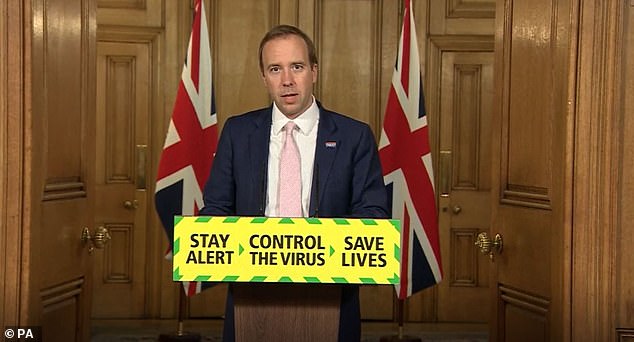
The Health Secretary made the announcement in tonight’s Downing Street press conference, saying ministers would be ‘guided by the science’
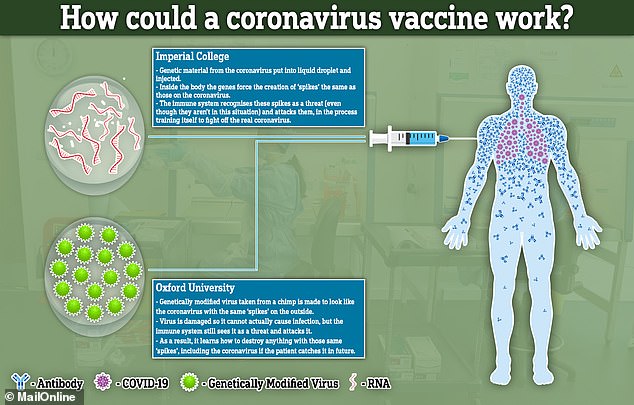
How the vaccines from Imperial College London and Oxford University would work


Pictured: Countries with over 10,000 more deaths than the five-year average. The US and UK have recorded the highest number of Covid deaths, but Ecuador has the highest excess fatalities as a percentage
Data from the COVID Symptom Tracker app suggests there are now only around 3,400 new cases of Covid-19 appearing each day in England, down from more than 11,000 per day a month ago
In other developments today:
- A 13-day-old baby with no underlying conditions became Britain’s youngest victim as the death toll rose by 135 to 42,288;
- Plans for a ‘travel corridor’ between the UK and France were in doubt as Mr Johnson and Emmanuel Macron failed to make a breakthrough;
- MPs urged England to follow Northern Ireland in allowing schools to operate with social distancing of just one metre;
- A day of good news on levels of infection provided growing evidence the outbreak is coming under control;
- The Bank of England governor warned Britain is facing the most dramatic rise in unemployment in his lifetime
Discussing the two groups of Britons who will be given priority access when a jab is eventually found, Mr Hancock said: ‘Just as we did for testing, we’ll be guided by the clinical science prioritising those in most need.’
The preliminary advice was issued this afternoon by the Joint Committee on Vaccination and Immunisation (JCVI), who recommended that both groups receive a Covid-19 jab first.
Mr Hancock said he was ‘very grateful’ for the advice, which was requested by the Department of Health and Social Care ‘to facilitate planning for the deployment of any safe and effective vaccine as soon as licensure is obtained for use in the UK’.
He added: ‘They recommend priority vaccinations for two groups, frontline health and social care workers, and those at increased risk of serious disease or death from coronavirus, including, for example, adults over the age of 50 and those with heart and kidney disease.
‘As we learn more about the virus we’ll continue to take into account which groups may be particularly vulnerable, including, for example, those from ethnic minority backgrounds.’
The JCVI guidance said frontline health and social care workers are at increased risk of being exposed to Covid-19, as well as transmitting the SARS-CoV-2 virus to vulnerable Britons in hospitals and care homes.
The committee labelled health workers as the highest priority for vaccination and told health chiefs doing so would also help ‘maintain resilience in the NHS and for health and social care providers’.
The JCVI — which consists of a dozen or more top scientists — advises ministers on all vaccines. It admitted its guidance for any UK Covid-19 vaccination scheme is likely to be modified in the future.
It added: ‘There is ongoing work within the UK to refine the identification of persons at risk of serious disease and mortality from Covid-19 infection.
‘As well as age and underlying co-morbid conditions, the committee notes that early signals have been identified of other potential risk factors, including deprivation and ethnicity.
‘As more evidence on at-risk groups emerges, this work will inform the review of the composition, and order of priority, of groups for vaccination.’
It added: ‘There are a number of unknown factors about any potential vaccines, and there are still important gaps in our understanding of COVID-19.
‘The committee will be keeping its advice under review and as more information becomes available will update its advice as and when deemed appropriate.’
As well as discussing who would be prioritised for any vaccine, Mr Hancock called on Brits to ensure they don’t avoid getting the MMR and other routine jabs.
He said: ‘Before I talk about coronavirus vaccines, I want to mention a very important reminder about other routine vaccines that are there to protect you.
‘Throughout the crisis, we’ve tried to keep the vaccination programmes for children and that has been largely successful.
‘But if you, or your child, is invited for a vaccine like MMR then please make sure you attend.
‘It’s very important that we don’t fall behind on the vaccination for other diseases because of this crisis.’
World Health Organization officials have already spoken of their fears that measles vaccination rates will plummet amid the pandemic.
Mr Hancock added: ‘In the long-run, the best way to defeat this virus is, of course, the discovery of a vaccine.’
He said since the start of the coronavirus crisis officials have ‘been supporting the most promising projects’, pointing to the experimental Imperial College London and Oxford University vaccines.
Mr Hancock said: ‘Our approach to vaccines is to throw everything at it as fast as we can, and to rigorously test to make sure they are safe before deployment.’
Mr Hancock also discussed AstraZeneca’s decision to start mass-manufacturing the experimental AZD1222 vaccine now.
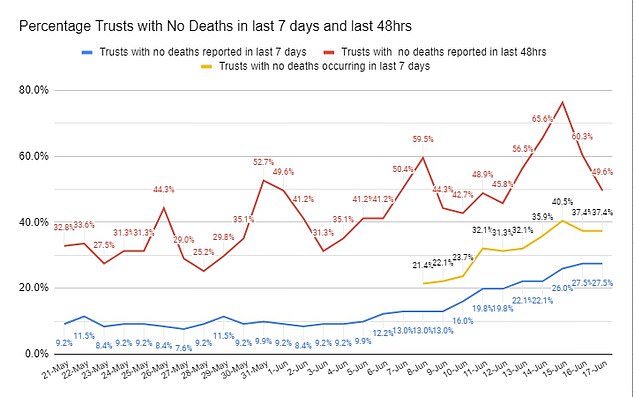
Data today also revealed one in three NHS hospital trusts — 49 out of 131 — in England have went a week without a Covid-19 death. Oxford University experts found half of the bodies haven’t recorded a fatality in 48 hours

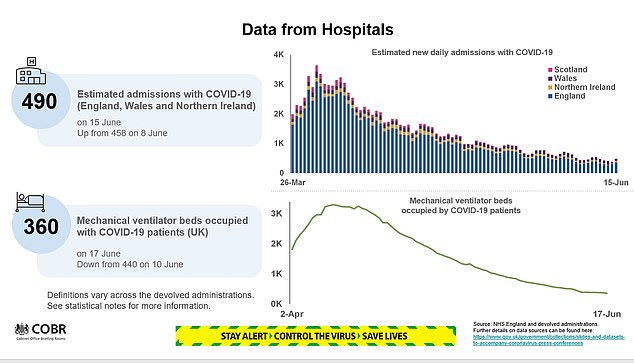
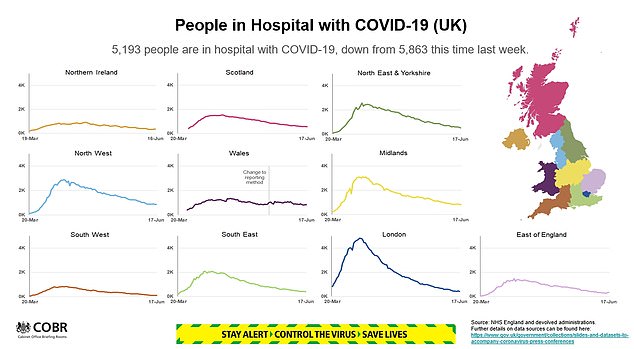

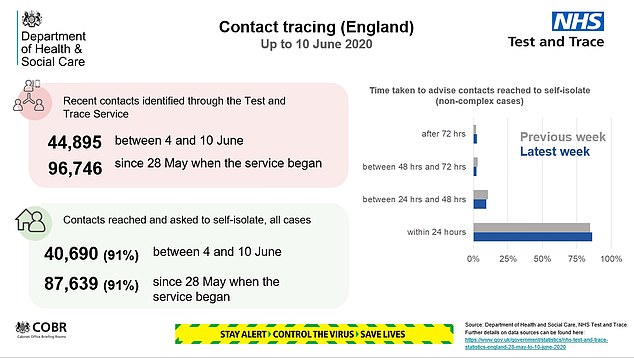

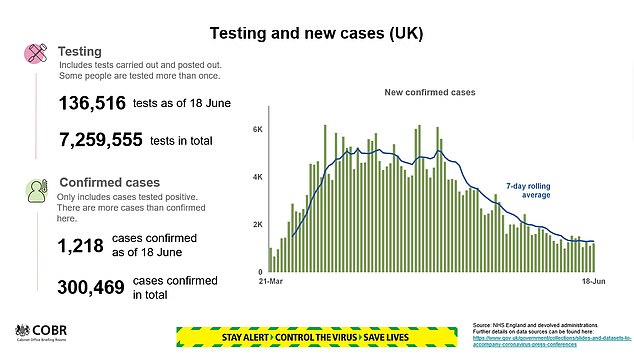
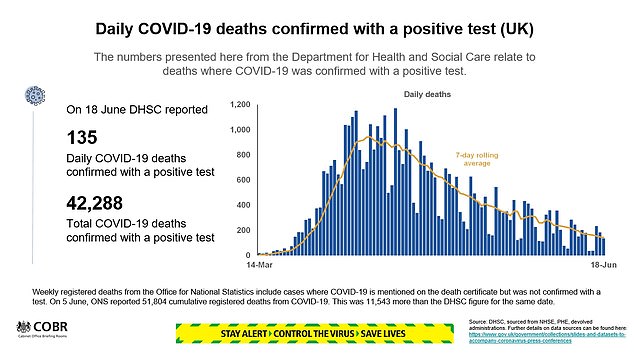
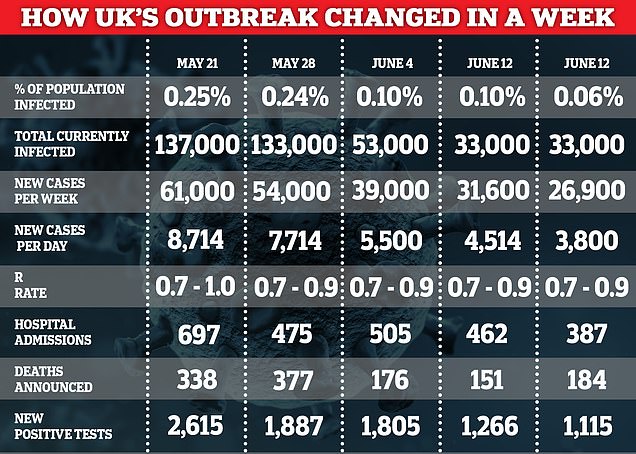

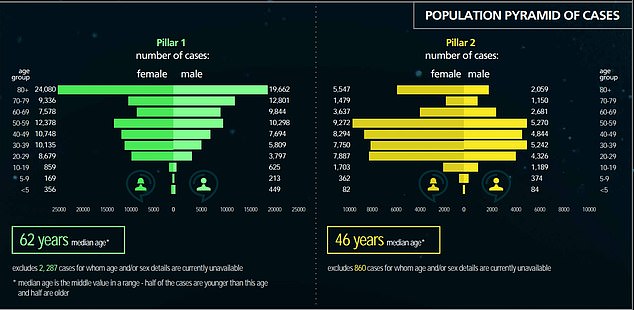


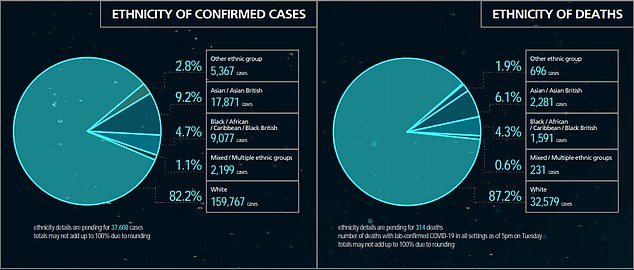
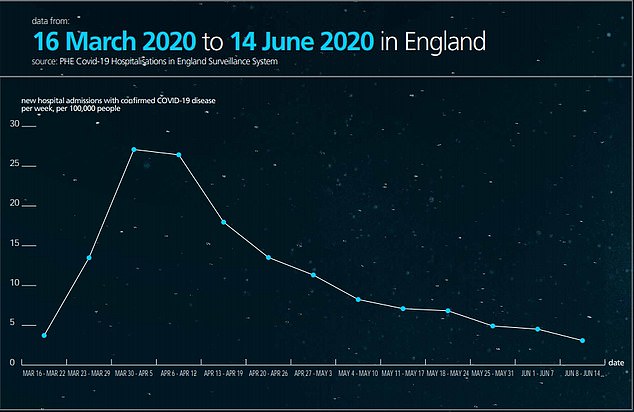
The jab — which the pharma giant’s chief executive believes will offer protection for a year — is currently being trialled on more than 10,000 people.
Mr Hancock said: ‘They’re starting manufacturing now, even ahead of approval so we can build up a stock pile and be ready should it be clinically approved.’
He said there will be sufficient supplies of the vaccine for those Brits most in need, ‘should the science come off’.
Stockpiles of the £5 steroid drug dexamethasone were built-up before health chiefs approved it for NHS use on Covid-19 patients requiring oxygen.
AstraZeneca is banking on the experimental jab working after signing multiple deals with countries around the globe to supply billions of doses of the vaccine.
The Cambridge-based firm last weekend agreed to dish out up to 400million doses in Germany, France, Italy and the Netherlands.
It has already inked deals to make 400million for the US as well as 100million for the UK, with the aim to start supplying them by October.
Oxford scientists announced this month that the vaccine was being partly trialled in Brazil because of fears the virus is dying out in the UK.
The Imperial College London vaccine — the second to be tested on humans in the UK — will work slightly differently.
The science behind both vaccine attempts hinges on recreating the ‘spike’ proteins that are found all over the outside of the COVID-19 viruses.
Both will attempt to recreate or mimic these spikes inside the body. The difference between the two is how they achieve this effect.
The Imperial jab will deliver genetic material (RNA) from the virus, which programs cells inside the patient’s body to recreate the spike proteins.
The Oxford University vaccine, on the other hand, will genetically engineer a virus to look like the coronavirus – but be unable to cause any infection.
The next part of the Imperial College London trial will involve 120 humans and will be scaled up to include 6,000 people, if it is proven to be safe.
But Professor Robin Shattock, the lead scientist, said the vaccine won’t be available until at least 2021 even if everything goes according to plan.
Matt Hancock insists he WILL get a COVID 19 tracking app that works after government ABANDONS beleaguered NHS version and announces it will use Apple and Google-based technology instead
Matt Hancock tonight insisted Britain will eventually get a Covid-19 tracking app that works after ministers abandoned NHS-made technology following its failure in a trial on the Isle of Wight.
Officials admitted today that the NHS app, once praised by the Health Secretary as vital for lifting lockdown and described by Boris Johnson as a central part of the UK’s test and trace system, did not work on Apple iPhones.
The health service’s digital arm, NHSX, has now ditched plans to create its own app and will work with Apple and Google to improve their existing technology. Officials refused to reveal how much money has been spent on the now-scrapped app.
Mr Hancock, appearing at today’s Downing Street press conference alongside the head of NHS test and trace Baroness Dido Harding, could not say when an tracking app would be ready amid claims it won’t be rolled-out until the winter.
Squeezing in a tribute to war-time singer Dame Vera Lynn, who died today aged 103, he said: ‘We’re not going to put a date on it… But I am confident we will get there — we will put that cherry on Dido’s cake.’
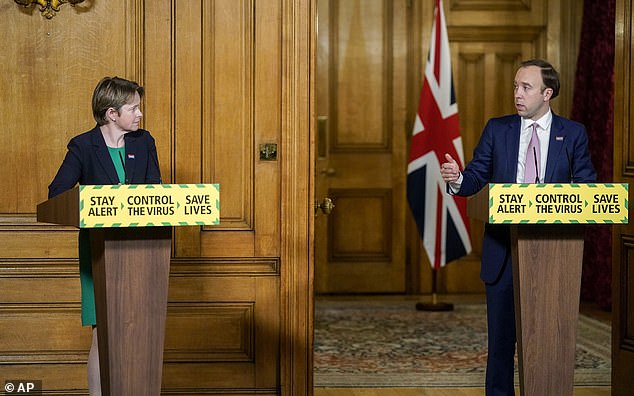
Health Secretary Matt Hancock said he is still committed to developing a Covid-19 contact tracing app, insisting he will follow through with putting the ‘cherry on the cake’ of the test and test system. Baroness Dido Harding, who is in charge of test and trace, today revealed the NHS’s app did not work on iPhones
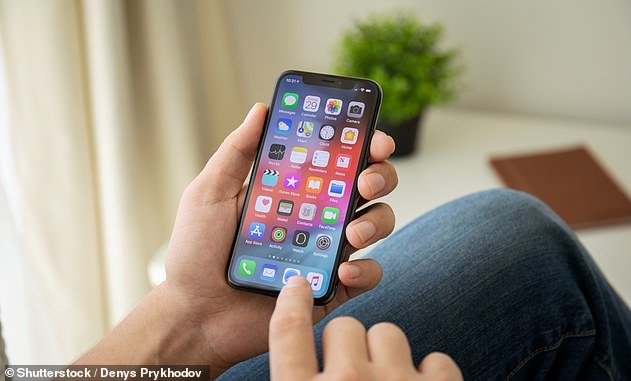
The app developed by the NHS didn’t work for people using Apple iPhones and effectively went into sleep mode, failing to pick up nearby devices using Bluetooth (stock image)
The app — which was originally promised for mid-May and the NHS spent months to develop — was unable to spot 25 per cent of nearby Android users and a staggering 96 per cent of iPhones in the Isle of Wight trial.
Meanwhile, the Apple and Google technology can spot 99 per cent of close contacts using any type of smartphone — but it cannot currently tell how far away they are, officials claimed today.
The leaders of Britain’s test and trace system said neither app is fit for purpose and Mr Hancock today appeared to point the finger at Apple for the failure, saying: ‘Our app won’t work because Apple won’t change their system’.
Apple and Google announced on April 10 that they would join forces to create the technology, by which time the NHS had already started work. All parties put their software into action around a month later, in mid-May.
Developers in the NHS will now work alongside the tech giants to try and roll its detection software and the NHS app’s distance-measuring ability — which they said was significantly better — together to make a hybrid app that actually works.
The Labour Party said ‘precious time and money’ had been wasted in the app fiasco, which represented further ‘poor management’ of the Covid-19 crisis, which has seen more than 42,000 Brits die of the disease.
The NHS app has faced a series of setbacks since ministers announced it was being developed, with experts raising serious privacy concerns, others saying it wouldn’t work in crowded tower blocks where people live in close proximity, and constant delays putting back its launch date at first by weeks and then months.
But senior politicians have stuck by the technology and promised it would come to fruition.
Matt Hancock told BBC Breakfast in May that it would be an ‘incredibly important part’ of Britain’s fight against the virus.
And Prime Minister Boris Johnson has repeatedly said the test and trace system, with the app as a central part of it, would be ‘world-beating’.
It has now emerged that the app simply didn’t work when used on Apple iPhones – it essentially went into sleep mode and was unable to detect 96 per cent of contacts.
Although it worked better on Android, detecting 75 per cent of phones nearby, it did not compare with the 99 per cent detection achieved by Apple and Google’s software.

That technology, however, could not tell how far away someone was and produced the same signal for people at three metres as it did for people at one metre.
The amount of time people spend within a certain distance of one another – currently two metres – is ‘mission critical’ for a contact tracing app, Mr Hancock said today.
People living in apartment buildings, for example, are likely regularly within three metres of someone but not actually in the same flat or even on the same floor.
NHS bosses now say they will pool the positives of both apps to try and create one which can be used in Britain in the future, but this is likely to take months.
Baroness Harding and Mr Gould, CEO of NHSX, the health service’s digital department, said today in a joint statement: ‘We have agreed to share our own innovative work on estimating distance between app users with Google and Apple – work that we hope will benefit others – while using their solution to address some of the specific technical challenges identified through our rigorous testing.’
The Government now says it will focus on contact tracing using human staff, for which it has hired 25,000 people.
Mr Hancock said: ‘We knew from the start that we would need to test and learn as we developed this new technology.
‘The NHS Covid-19 app has undergone some of the most rigorous testing in the world – utilising a real world trial on the Isle of Wight pilot and in a series of field tests – and I want to thank all of those involved…
‘Countries across the globe have faced challenges in developing an app which gets all of these elements right, but through ongoing international collaboration we hope to learn, improve and find a solution which will strengthen our global response to this virus.’
MailOnline has contacted Google and Apple for comment.
